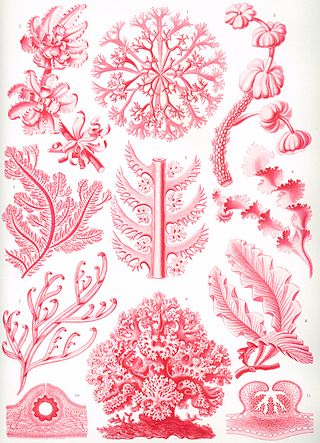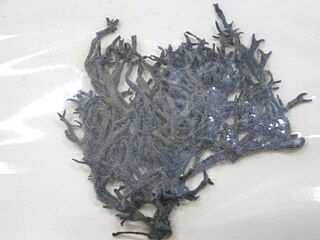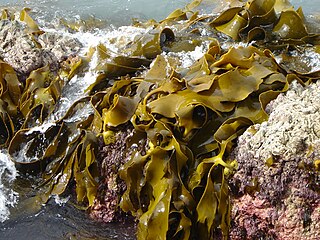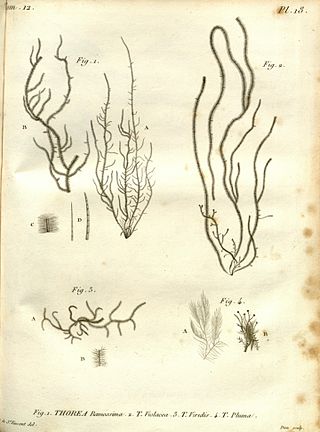Related Research Articles

Pfiesteria is a genus of heterotrophic dinoflagellates that has been associated with harmful algal blooms and fish kills. Pfiesteria complex organisms (PCOs) were claimed to be responsible for large fish kills in the 1980s and 1990s on the coast of North Carolina and in tributaries of the Chesapeake Bay. In reaction to the toxic outbreaks, six states along the US east coast have initiated a monitoring program to allow for rapid response in the case of new outbreaks and to better understand the factors involved in Pfiesteria toxicity and outbreaks. New molecular detection methods have revealed that Pfiesteria has a worldwide distribution.

Florideophyceae is a class of exclusively multicellular red algae. They were once thought to be the only algae to bear pit connections, but these have since been found in the filamentous stage of the Bangiaceae. They were also thought only to exhibit apical growth, but there are genera known to grow by intercalary growth. Most, but not all, genera have three phases to the life cycle.

Selenastraceae is a family of green algae in the order Sphaeropleales. Members of this family are common components of the phytoplankton in freshwater habitats worldwide. A few species have been found in brackish and marine habitats, such as in the Baltic Sea.
Crustomastix is a genus of green algae in the class Mamiellophyceae.
Selenastrum is a genus of green algae in the family Selenastraceae. It is common in freshwater habitats around the world. Most species prefer temperate or warm-temperate waters.

Bolidophyceae is a class of photosynthetic heterokont picophytoplankton, and consist of less than 20 known species. They are distinguished by the angle of flagellar insertion and swimming patterns as well as recent molecular analyses. Bolidophyceae is the sister taxon to the diatoms (Bacillariophyceae). They lack the characteristic theca of the diatoms, and have been proposed as an intermediate group between the diatoms and all other heterokonts.

Nemastomatales is an order of red algae. It includes some members of the defunct order Cryptonemiales.
Onslowiaceae is the only family in order Onslowiales in the brown algae. The family contains only the genera Onslowia and Verosphacela.

Ishigeales is an order of brown algae. It includes two families, Ishigeaceae and Petrodermataceae. The genus Diplura is also included, but not placed to family.

Phlorotannins are a type of tannins found in brown algae such as kelps and rockweeds or sargassacean species, and in a lower amount also in some red algae. Contrary to hydrolysable or condensed tannins, these compounds are oligomers of phloroglucinol (polyphloroglucinols). As they are called tannins, they have the ability to precipitate proteins. It has been noticed that some phlorotannins have the ability to oxidize and form covalent bonds with some proteins. In contrast, under similar experimental conditions three types of terrestrial tannins apparently did not form covalent complexes with proteins.

Apophlaea is a genus of thalloid algae that is endemic to New Zealand. This genus has two species, both from the high intertidal zone on New Zealand's coasts. Specimens can reach around 15 cm in size. The thalli take a crustose form, but also contain upright, branching frond-like protrusions that reach 5–8 cm in height. Secondary pit connections and secondary pit connectionsare present in the organisms. Apophlaea reproduces by means of conceptacles; it produces tetraspores.

Adamsiella is a genus of red alga closely related to the genus Lenormandia. The holotype species for the genus is Adamsiella melchiori L.E. Phillips & W.A. Nelson.

Ulvaria obscura is an intertidal and subtidal benthic marine algae found in temperate and Arctic ocean waters around the world.
Sirogonium is a genus of filamentous charophyte green algae of the order Zygnematales. It is found in freshwater areas on all continents but Antarctica. Spirogyra measures approximately 32–115 μm in width. Each cell contains 2–10 chloroplasts in a ribbon, in contrast to the closely related genus Spirogyra, which has chloroplasts in a coil. Molecular phylogenetic studies have placed Sirogonium inside a clade consisting of Spirogyra species; in other words, Spirogyra is paraphyletic with respect to Sirogonium.

Prof. Zvi HaCohen is an Israeli scientist who, since August 2010, has served as Rector of Ben-Gurion University of the Negev (BGU).

Batrachospermaceae is a family of fresh water red algae (Rhodophyta). Genera within the Batrachospermaceae generally have a "Lemanea-type" life history with carpospores germinating to produce chantransia. Sporophyte phase with meiosis occurs in an apical cell to produce the gametophyte stage. Pit connections have two pit plug cap layers with the other layer enlarged. This family of freshwater red algae is uniaxial, meaning each filament with a single apical cell. The genera included within Batrachospermaceae are listed in the table below.

Pyrenomonadaceae is a family of cryptomonads which includes three or four known genera. They are distinguished from other cryptomonads by their nucleomorphs being imbedded into the pyrenoid, and the presence of distinctive pigment phycoerythrin 545.
Chroomonadaceae is a family of cryptomonads first recognized by Clay et al in 1999 as including genera Chroomonas, Falcomonas, and Komma. Following a molecular phylogenic study in 2002, Hemiselmis was also placed within the Chroomonadaceae. Today, the family is generally recognized as sister to the Pyrenomonadaceae.
Joanna M. Jones was a phycologist, marine biologist and diver. She researched kelp forest ecology adding to the scientific knowledge on its population, reproduction, competition and growth as well as descriptions of subcanopy seaweeds found in kelp forests. She was president of the British Phycological Society from 1987 to 1988.

Thoreales is an order of red algae belonging to the class Florideophyceae. The order consists only one family, ThoreaceaeHassall, 1845. The family of Thoreaceae was circumscribed by Arthur Hill Hassall in A history of the British freshwater algae, including descriptions of the Desmideae and Diatomaceae in 1845.
References
- ↑ Gavio, B.; Fredericq, S. (2002), "New Insights in the Cryptonemiales-Rhodymeniales Complex and Resurrection of the Allied Red Algal Order Nemastomatales Kylin 1925 as Inferred From rbcL Sequence Analysis and Comparative Reproductive Morphology", Journal of Phycology, 38 (s1): 12–12, doi:10.1046/j.1529-8817.38.s1.36.x
- ↑ Saunders, G.W.; Kraft, G.T. (2002), "Two New Australian Species of Predaea (nemastomataceae, Rhodophyta) with Taxonomic Recommendations …", J Phycol, 38 (6): 1245–1260, doi:10.1046/j.1529-8817.2002.02039.x